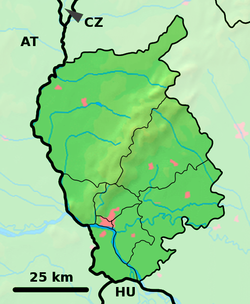|
Modra
Modra (German: Modern, Hungarian: Modor, Latin: Modur) is a city and municipality in the Bratislava Region in Slovakia. It has a population of 9,201 as of 2013. It nestles in the foothills of the Malé Karpaty (Little Carpathian mountains) and is an excellent centre for hiking. Modra is famous for its pottery industry. Its blue-and-white porcelain is famous throughout Slovakia. It is also known as one of the most important viticulture centres in the Little Carpathians region. Besides the main town, there are also other adjacent settlements incorporated in the municipality: former vassalage viticulture village Kráľová and two recreational hamlets of Harmónia and Piesok (also known as Zochova Chata), both located in the woods of Little Carpathians mountains. EtymologyMost experts agree that the name is connected to Slovak: modrá (blue).[5] The name probably originates from another historic geographic name in the neighbourhood, e.g, Modrá hora (Blue Mountain). According to a less probable hypothesis, the name comes from Hungarian: madár (a bird).[5] HistoryThe first traces of habitation go back to the 3rd millennium BCE, and the first permanent habitation dates back to the time of Great Moravia, when the Slavs lived there. The first mention of Modra was in 1158 in a document of the Géza II of Hungary, when it belonged to the bishop of Nitra. After the Mongol invasion of 1241, the settlement was reconstructed by the German colonists. The first mention of vineyards goes back to 1321. The settlement received its town privileges in 1361 and became a free royal town in 1607. The town fortifications with three gates were constructed in 1610–1647. Since the 17th century, it has been one of the leading craft centers in present-day Slovakia. The ceramic industry and majolica production started in the 19th century. In 1883, a school of ceramics was established, where through the skillfulness of Habaners, the so-called Slovak ceramics were created. The railway track from Bratislava to Trnava bypassed the town in the 1840s, as the local magistrate refused to allow the railway construction. Landmarks
Demographics
According to the 2001 census, the town had 8,536 inhabitants. 97.4% of inhabitants were Slovaks, 1% Czechs and 0.4% Hungarians.[8] Structure of religion: 53.7% Roman Catholics, 25.8% Lutherans, and 15% with no confession.[8] Modra in fictionIn 2010 the Canadian film director Ingrid Veninger made a film about returning to the town after many years in Canada, called MODRA, starring Alexander Gammal and her daughter Hallie Switzer. Notable people
Twin towns — sister citiesModra is twinned with:[9][10][11]
See alsoReferences
External links
|
||||||||||||||||||||||||||||||||||||||||||||||||||||||||||||||||||||||




